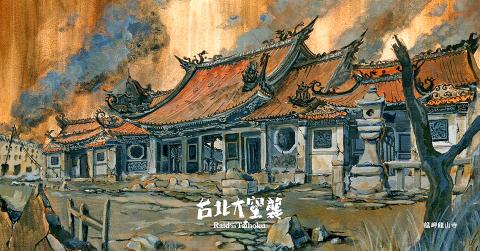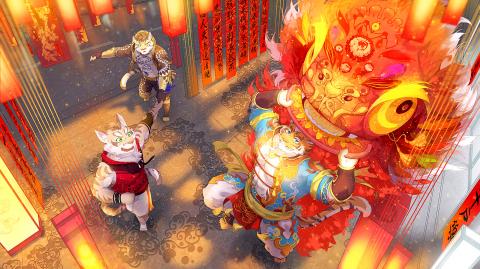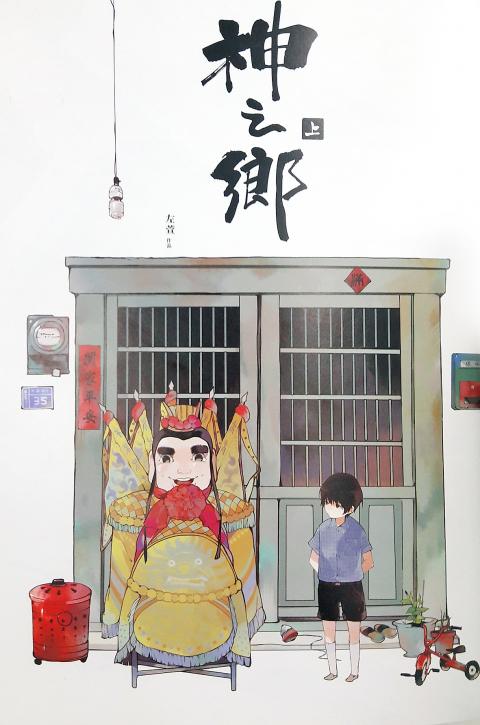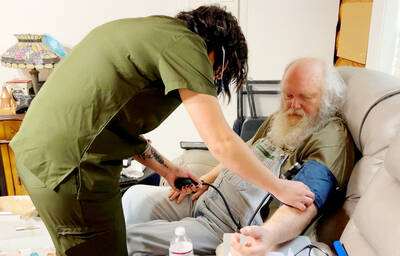Writer Lo Tao (羅濤) doesn’t see any reason not to set his stories in Taiwan and imbue them with Taiwanese elements — even if the product is a video game featuring a gay character who romances anthropomorphic animals.
Lo is the primary writer for Nekojishi (家有大貓), which features characters inspired by Taiwanese folklore. He is among a growing number of comic artists, game producers and other creative types looking to local history and culture for inspiration. They don’t feel that the relative obscurity of Taiwanese culture is a barrier to marketing. Indeed, they are convinced it will appeal to local consumers as something familiar and also pique the curiosity of foreigners.
“My story happens in Taiwan, so it’s a given that it’s going to have Taiwanese elements. But making the game fun and telling a good story are more important,” he says. “And if people learn more about Taiwanese culture after playing it and want to delve deeper, well, that’s great.”

Photo courtesy of Teenage Riot Studio
CHANGING TAIWANESE-NESS
This type of thinking was not always the case, and most Taiwanese grew up with Japanese or American comics, cartoons and games. Even if there were products by Taiwanese creators, they mostly followed a foreign style.
In fact, people once pooh-poohed “Taiwanese-ness.” KJ Chang (張少濂), who is part of a team developing a board game based on the 1945 Taipei Air Raid, says that referring to someone as hentai (很台, “very Taiwanese”), it implies an unrefined person with poor taste in dress and manner.

Photo courtesy of Nekojishi
“It’s ridiculous to use one’s own birthplace to describe something like that,” he says. “And when designers make something refined, people will say, ‘Oh, that’s very Japanese.’ They don’t realize that Taiwanese style is simply moving in a more positive direction.”
Chang says that the shift is due to the increased civic awareness of recent years.
“Young people are starting to search for their roots,” he says.

Photo courtesy of Zuo Hsuan
Zuo Hsuan (左萱) is the author of The Summer Temple Fair (神之鄉), a comic book revolving around the santaizi (三太子) religious procession in her hometown of Dasi (大溪) in Taoyuan. She says Taiwanese-ness can go beyond the religious and folk elements, as even something as mundane as buying noodles can be uniquely Taiwanese.
“A Taiwanese doing or reacting to something will certainly be different from an American or Japanese doing the same thing,” she says. “Also, I think my dialogue is very Taiwanese too.”
Zuo says that she grew up reading Japanese comics, but recalls that when she and her friends would draw comics at school, it would always be about their daily lives.
“You can find much inspiration in your surroundings,” she says. “I think more Taiwanese are starting to discover that there are many topics around them that they can expand upon.”
Despite Nekojishi’s themes of homosexuality and furry subculture, this “every day life” notion is also what Lo strives for. He says that he has given all the characters realistic names, such as an anthropomorphic leopard cat named Yen Shu-chi (嚴書齊).
“This is a story that happens in modern day Taipei, and I wanted to portray it as realistically as possible,” he says. “That goes for my characters too. I’ll give them conventional names.”
“The main character is a pretty regular person, just like most of our audience,” Lo’s teammate Sheng Hang (聖航) adds. “It’s his experiences that are unusual.”
EXTENSIVE RESEARCH
Chang says when he surveyed 40 young people in Ximending, only two knew about the Taipei Air Raid, which heavily damaged Taipei and killed many people. Even Chang only heard his father talk about it a few times.
“There are many gaps in our historical memory,” he says. “Taiwan has been ruled by too many different people with different educational agendas.”
But it’s exactly this general unfamiliarity with Taiwanese history and culture that makes the subject a treasure trove for creative inspiration, Chang adds.
“We’re not like Americans or Europeans who seem very familiar with their history,” he says. “There are still many local stories waiting to be found, and as Taiwanese we are the best candidates to interpret them because they belong to us.”
Chang’s team has gone to great lengths to keep their game historically accurate, consulting experts on topics ranging from the damage to the buildings to the characters’ interests to what people would name their cats and dogs in that era.
“Since this topic is uniquely ours, it’s up to us to make it as detailed as possible,” designer Boyea Lai (賴柏燁) says.
Most of Lo’s team also had no idea about the Tiger Lord (虎爺) mythology featured in the game, and he also consulted with Aboriginals for a snow leopard character from the Rukai tribe. And even Zuo, who grew up watching the Santaizi procession, spent about two years researching and experiencing the ceremony to present an authentic picture.
NO PREACHING
Although Taiwanese elements are prevalent in all three productions, Zuo, Chang and Lo all say that it should not be treated as a gimmick to attract attention, nor should the product be overly preachy about Taiwanese culture.
Lo says if people want to learn more about the cultural terms brought up in Nekojishi, they can visit a separate information section. And the producers give people a special gift as incentive to visit and pray at a Tiger Lord temple after they play the game.
“If you overly emphasize Taiwanese culture, it will destroy the flow of the game,” he says. “People just want to relax and play, and you’ll ruin that by dumping a bunch of knowledge on them. We want them to like the game first, not tell them what they should learn.”
Chang takes a similar approach. The team has detailed all the American airstrikes in Taiwan during World War II in two books that can be ordered separately.
Zuo says that even though her comic revolves around religious practices, the story of friendship, family and homecoming is what will attract people.
“It won’t feel like a class if you’re learning through a comic,” she says. “You’ll absorb the material naturally.”
Chang adds that people should not overly rely on the attention created by making something Taiwanese, as Taiwanese-ness alone will not be enough.
“[Author] Giddens Ko (柯景騰) once said, ‘I don’t support Taiwanese movies. I only support good movies,’” he says. “Many foreigners have taken an interest in our game because they love the artwork. We have to make something that is competitive internationally regardless of how Taiwanese it is. That’s the direction we are moving towards.”

Oct. 27 to Nov. 2 Over a breakfast of soymilk and fried dough costing less than NT$400, seven officials and engineers agreed on a NT$400 million plan — unaware that it would mark the beginning of Taiwan’s semiconductor empire. It was a cold February morning in 1974. Gathered at the unassuming shop were Economics minister Sun Yun-hsuan (孫運璿), director-general of Transportation and Communications Kao Yu-shu (高玉樹), Industrial Technology Research Institute (ITRI) president Wang Chao-chen (王兆振), Telecommunications Laboratories director Kang Pao-huang (康寶煌), Executive Yuan secretary-general Fei Hua (費驊), director-general of Telecommunications Fang Hsien-chi (方賢齊) and Radio Corporation of America (RCA) Laboratories director Pan

President William Lai (賴清德) has championed Taiwan as an “AI Island” — an artificial intelligence (AI) hub powering the global tech economy. But without major shifts in talent, funding and strategic direction, this vision risks becoming a static fortress: indispensable, yet immobile and vulnerable. It’s time to reframe Taiwan’s ambition. Time to move from a resource-rich AI island to an AI Armada. Why change metaphors? Because choosing the right metaphor shapes both understanding and strategy. The “AI Island” frames our national ambition as a static fortress that, while valuable, is still vulnerable and reactive. Shifting our metaphor to an “AI Armada”
The consensus on the Chinese Nationalist Party (KMT) chair race is that Cheng Li-wun (鄭麗文) ran a populist, ideological back-to-basics campaign and soundly defeated former Taipei mayor Hau Lung-bin (郝龍斌), the candidate backed by the big institutional players. Cheng tapped into a wave of popular enthusiasm within the KMT, while the institutional players’ get-out-the-vote abilities fell flat, suggesting their power has weakened significantly. Yet, a closer look at the race paints a more complicated picture, raising questions about some analysts’ conclusions, including my own. TURNOUT Here is a surprising statistic: Turnout was 130,678, or 39.46 percent of the 331,145 eligible party

The older you get, and the more obsessed with your health, the more it feels as if life comes down to numbers: how many more years you can expect; your lean body mass; your percentage of visceral fat; how dense your bones are; how many kilos you can squat; how long you can deadhang; how often you still do it; your levels of LDL and HDL cholesterol; your resting heart rate; your overnight blood oxygen level; how quickly you can run; how many steps you do in a day; how many hours you sleep; how fast you are shrinking; how